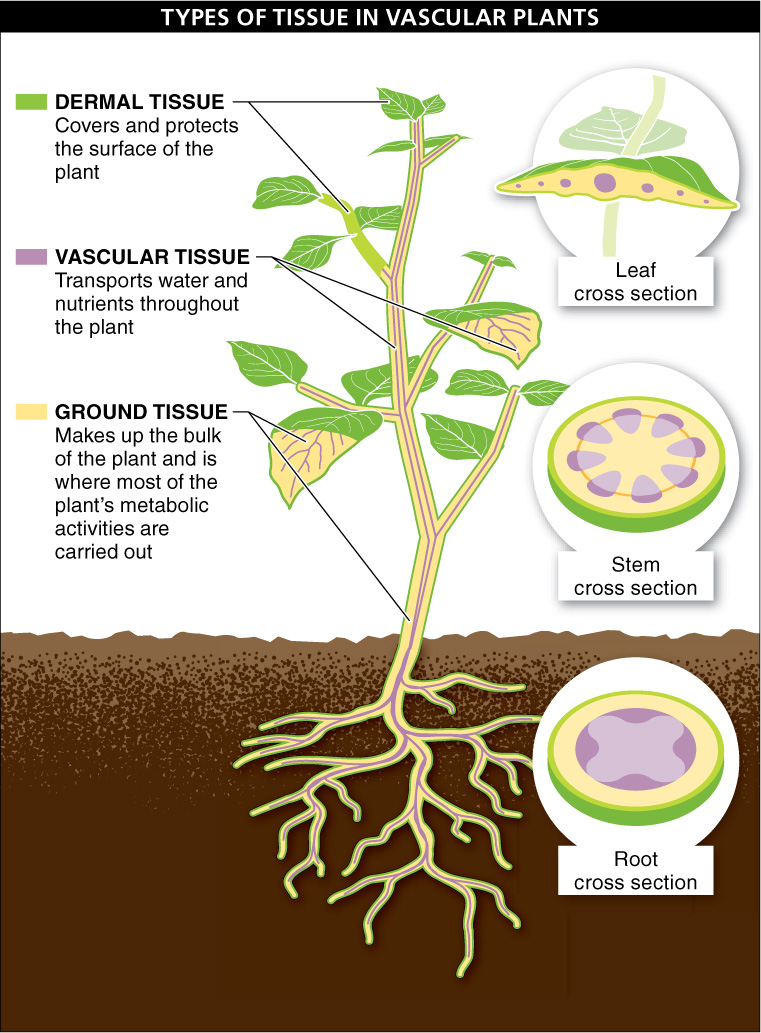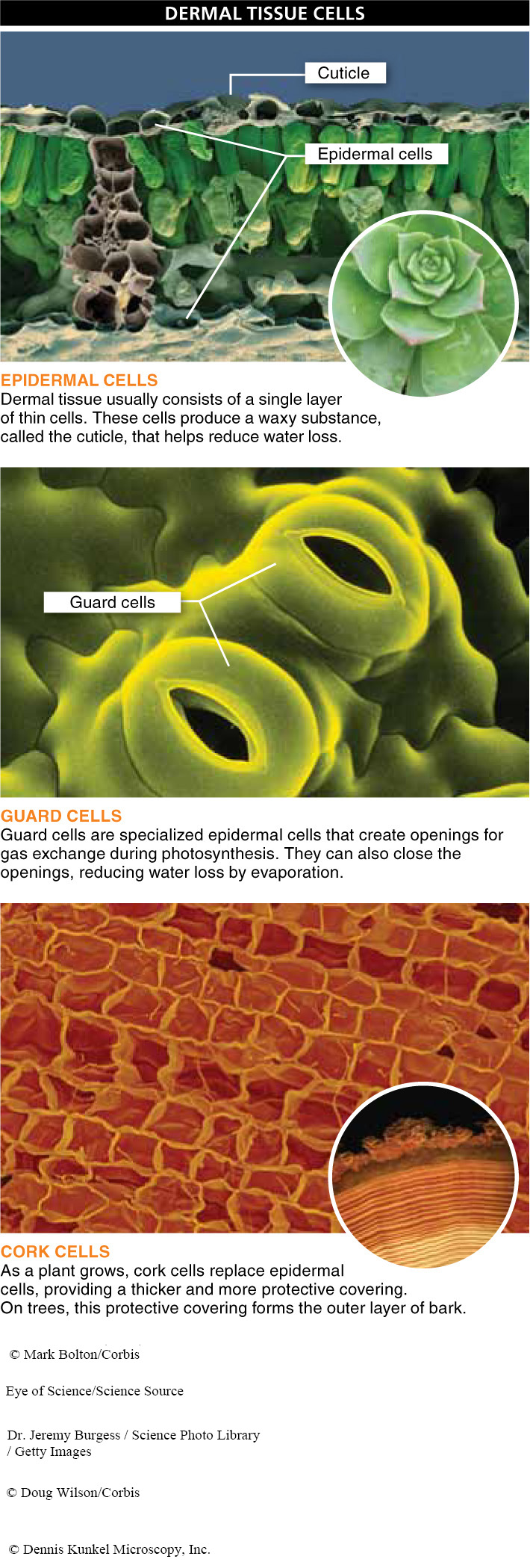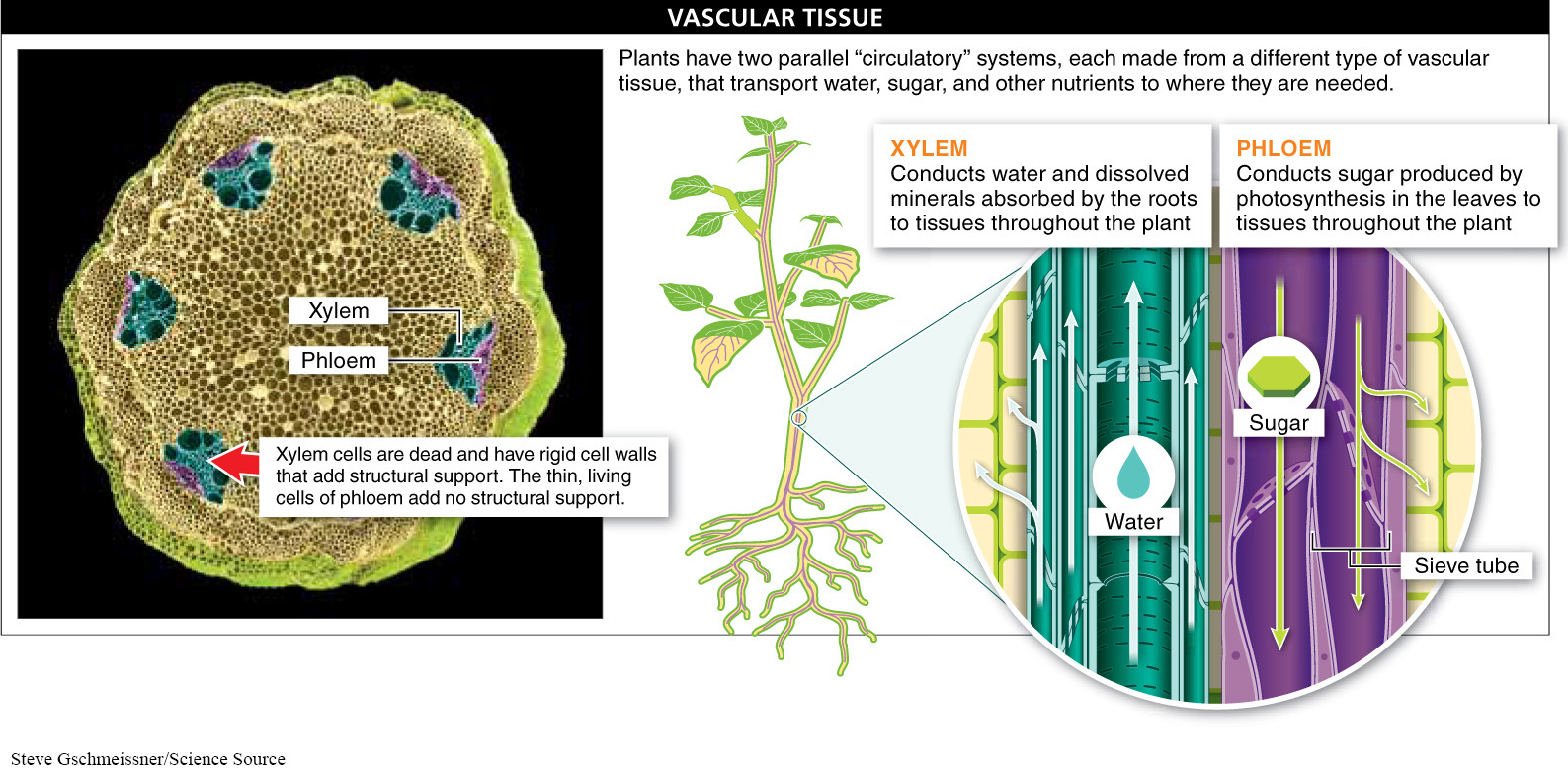

Take a look at some common plants—
In this chapter, we focus on vascular plants. All vascular plants are organized around the same basic body plan and built up from the same three types of tissues. Leaves, stems, roots, and flowers—
- 1. Dermal tissue, which covers and protects the surface of the plant, much like skin covers the human body.
- 2. Vascular tissue, which transports water and nutrients throughout the plant body, acting much like the circulatory system in vertebrates. (It’s important to note, however, that circulation in plants differs in one huge way from circulation in animals: plants have no heart. In fact, they have no pump at all.)
- 3. Ground tissue, which makes up the bulk of the plant and is where most of the plant’s metabolic activities are carried out.
692
Each of the three tissue types, discussed in detail in the following text, is composed of one or more different types of plant cells. Recall from Chapter 3 that plant cells commonly differ from other eukaryotic cells in several ways: they may contain chloroplasts (the sites of photosynthesis), they may contain a large central vacuole (serving several functions, including storage of nutrients, waste products, or both; see Section 3-
Dermal Tissue Like the skin of an animal, a plant’s dermal tissue covers and protects the entire plant (FIGURE 17-6). Dermal tissue usually consists of a single layer of tightly packed, very thin cells, called epidermis. Because it may be exposed to dry air and a plant can’t move out of the sun on a hot day, the epidermis produces a waxy covering, called the cuticle, that helps reduce some of the water loss due to evaporation. The cuticle also offers a small level of protection from pathogens and microorganisms that might attempt to eat the plant. The epidermal cells of roots, however, do not secrete a cuticle, because a cuticle would reduce the root cell’s ability to perform one of its primary functions—
The epidermis also has some specialized cells, called guard cells, that help to regulate the gases coming into and out of leaves. Two guard cells surrounding a pore in the leaf can change their shape to create an opening through which gases (including carbon dioxide and oxygen) can be exchanged during photosynthesis. The guard cells can also change shape to close the opening, an action that seals off the inside tissues and minimizes water loss by evaporation (see Section 4-
In many vascular plants, as the plant continues to grow and increases in girth, the epidermis covering the stems and roots is replaced by a thicker, more protective dermal covering. This protective covering consists mostly of dead cork cells. Cork cells contain a waxy, fatty substance that makes the tissue impermeable to water and resistant to fire and decay. Small pores interspersed among the cork cells, however, allow gas exchange. On trees, this protective covering forms the outer layer of bark. The thick covering balances two conflicting needs: the need to protect the living tissue inside the tree from risks such as fire and predation and the need for gas exchange—
693
Vascular Tissue As we saw earlier, plants can grow to be very large, and when they are large, they must have a system for getting nutrients to and removing waste products from all parts of the plant, from the bottommost roots to the topmost leaves. The transport of nutrient and waste molecules is the function of vascular tissue, which plays a role analogous to that of the circulatory system in animals (FIGURE 17-7). Most sugar, for example, is produced in the leaves (high up on the plant), while most water is absorbed through the roots (located underground). Because all plant cells require both water and sugar to survive, the physical separation of the leaves and roots is overcome by the vascular tissue that links them.

There are two parallel transport systems in vascular plants, each made from a different type of vascular tissue and each transporting a fluid called sap. (Keep in mind that, unlike animal circulatory systems, plant systems simply transport fluids from one place to another in the plant rather than circulating them in one direction.) One type of vascular tissue is called xylem (pronounced ZY-luhm). It conducts xylem sap, containing water and dissolved minerals, from the roots to the rest of the plant body. The other vascular tissue type is called phloem (pronounced FLOW-uhm). It conducts phloem sap, consisting mostly of water but also containing sugar—
Cells that have already died are among the most important parts of a plant. Why?
Plants build some structures in ways completely unheard of in animals. For example, the tubes of the xylem are made from cells that are dead. The cells grow close together and, after their death, become connected to one another, end to end, to form the outer surface of a pipeline. There are many of these pipelines parallel to each other. Water then flows through the pipelines and reaches all the living cells in the plant through tiny holes in the cell walls, in much the same way that a gardener’s soaker hose, with hundreds of small holes, waters a large area of grass or garden. The rigid cell walls that make up the pipelines also give the plant structural support, like the girders of a building.

The other transport system, the phloem, is built from cells that remain alive while functioning as another sort of pipe. These cells are arranged end to end to form pipe-
694
Ground Tissue The third type of tissue found in plants is called ground tissue. Because ground tissue includes everything that is neither the outer covering (dermal tissue) nor the inner vascular tissue (xylem and phloem), it makes up most of the plant body. There are three different types of ground tissue (FIGURE 17-8).
- 1. Parenchyma cells make up the majority of plant tissue, including most of the soft, flexible tissue found in leaves, flowers, stems, roots, and fruits. Parenchyma cells are the workhorses of the plant body, and they carry out most of the plant’s metabolic activities. Depending on their location, parenchyma cells have the capacity to photosynthesize, store food molecules, produce ATP through cellular respiration, or produce and release hormones. When you eat a carrot or a potato, the carbohydrate-
packed cells you consume are primarily parenchyma cells that were storing energy for the plant to use at a later time. When a plant is damaged, it is parenchyma cells that divide to repair the injured tissue. - 2. Collenchyma cells are elongated, stringy cells with thickened cell walls. This might at first seem like sloppy cell construction, but it is this construction that gives a plant great flexibility, enabling it to twist and bend. An example of collenchyma tissue is the strings on the outside of a celery stalk.
- 3. Unlike the other types of ground tissue, sclerenchyma cells are not living when they are mature. They have very thick cell walls containing lignin, a substance that is one of the chief chemical components of wood and that makes the cell walls in woody plants indigestible to nearly all organisms. Sclerenchyma cells are very strong and can function like the steel girders of a building, enabling plants to resist the force of gravity and grow very tall. Fibrous sclerenchyma cells are used to make cloth, rope, and paper.
TAKE-HOME MESSAGE 17.3
All vascular plants are organized around the same basic body plan and built from the same three types of tissue. Dermal tissue covers and protects the surface of the plant. Vascular tissue transports water, sugars, and minerals throughout the plant body. And ground tissue, which makes up the bulk of the plant, is where most of the plant’s metabolic activities take place.
Name the three types of tissue in vascular plants, and briefly describe the role of each.
Dermal tissue covers and protects the surface of the plant, much like skin covers the human body; vascular tissue transports water and nutrients throughout the plant body, acting much like the circulatory system in vertebrates; and ground tissue, which makes up the bulk of the plant, is where most of the plant's metabolic activities are carried out.
695